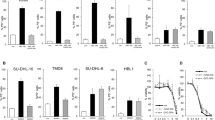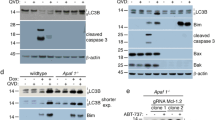Abstract
Galectin-1 (gal-1) triggers T cell death by several distinct intracellular pathways including the activation of the death-receptor pathway. The aim of this study was to investigate whether gal-1 induced activation of the death-receptor pathway in Jurkat T lymphocytes mediates apoptosis via the mitochondrial pathway linked by truncated Bid (tBid). We demonstrate that gal-1 induced proteolytic cleavage of the death agonist Bid, a member of the Bcl-2/Bcl-xL family and a substrate of activated caspase-8, was inhibited by caspase-8 inhibitor II (Z-IETD-FMK). Downstream of Bid, gal-1 stimulated mitochondrial cytochrome c release as well as the activation and proteolytic processing of initiator procaspase-9 were effectively decreased by caspase-8 inhibitor II. Blocking of gal-1 induced cleavage of effector procaspase-3 by caspase-8 inhibitor II as well as by caspase-9 inhibitors I (Z-LEHD-FMK) and III (Ac-LEHD-CMK) indicates that receptor and mitochondrial pathways converged in procaspase-3 activation and contribute to proteolytic processing of effector procaspase-6 and -7. Western blot analyses and immunofluorescence staining revealed that exposure of Jurkat T cells to gal-1 resulted in the cleavage of the DNA-repair enzyme poly (ADP-ribose) polymerase, cytoskeletal α-fodrin, and nuclear lamin A as substrates of activated caspases. Our data demonstrate that Bid provides a connection between the death receptor and the mitochondrial pathway of gal-1 induced apoptosis in human Jurkat T lymphocytes.










Similar content being viewed by others
Abbreviations
- Bp:
-
Base pair
- BSA:
-
Bovine serum albumin
- CD:
-
Cluster of differentiation
- CHAPS:
-
3-[(3-Cholamidopropyl)dimethylammonio]-1-propanesulfonate
- CRD:
-
Carbohydrate recognition domain
- DTT:
-
Dithiothreitol
- ECL:
-
Enhanced chemiluminescence
- EDTA:
-
Ethylene-diaminetetraacetic acid
- EGTA:
-
Ethylene glycol-bis(2-aminoethylether)-N,N,N′,N′-tetraacetic acid
- FCS:
-
Fetal calf serum
- Gal-1:
-
Galectin-1
- HEPES:
-
N-2-hydroxyethyl-piperazine-N-2-ethanesulfonic acid
- IgG:
-
Immunoglobulin G
- HRP:
-
Horseradish peroxidase
- kDa:
-
kilodalton
- mAb:
-
Monoclonal antibody
- NP-40:
-
Nonidet P-40
- pAb:
-
Polyclonal antibody
- PIPES:
-
Piperazine-N,N′-bis(2-ethanesulfonic) acid
- PAGE:
-
Polyacrylamide gel electrophoresis
- PARP:
-
Poly (ADP-ribose) polymerase
- PBS:
-
Phosphate-buffered saline
- PI:
-
Propidium iodide
- SDS:
-
Sodium dodecyl sulphate
- TBS:
-
Tris-buffered saline
- TCR:
-
T cell receptor
- Tris:
-
Tris(hydroxymethyl) aminomethane
- T:
-
Tween 20
References
Amano M, Galvan M, He J, Baum LG (2003) The ST6Gal I sialyltransferase selectively modifies N-glycans on CD45 to negatively regulate galectin-1-induced CD45 clustering, phosphatase modulation, and T cell death. J Biol Chem 278:7469–7475
Baum LG, Blackall DP, Arias-Magallano S, Nanigian D, Uh SY, Browne JM, Hoffmann D, Emmanouilides CE, Territo MC, Baldwin GC (2003) Amelioration of graft versus host disease by galectin-1. Clin Immunol 109:295–307
Blaser C, Kaufmann M, Müller C, Zimmermann C, Wells V, Mallucci L, Pircher H (1998) β-galactoside binding protein secreted by activated T cells inhibits antigen-induced proliferation of T cells. Eur J Immunol 28:2311–2319
Bradford MM (1976) A rapid and sensitive method for the quantitation of microgram quantities of protein utilizing the principle of protein-dye binding. Anal Biochem 72:248–254
Brandt B, Büchse T, Abou-Eladab EF, Tiedge M, Krause E, Jeschke U, Walzel H (2008) Galectin-1 induced activation of the apoptotic death-receptor pathway in human Jurkat T lymphocytes. Histochem Cell Biol 129:599–609
Brauns SC, Dealtry G, Milne P, Naude R, Van de Venter M (2005) Caspase-3 activation and induction of PARP cleavage by cyclic dipeptide cyclo(Phe-Pro) in HT-29 cells. Anticancer Res 25:4197–4202
Brewer CF (2002) Binding and cross-linking properties of galectins. Bichim Biophys Acta 1572:255–262
Chung CD, Patel VP, Moran M, Lewis LA, Miceli MC (2000) Galectin-1 induces partial TCR ζ-chain phosphorylation and antagonizes processive TCR signal transduction. J Immunol 165:3722–3729
Daniels MA, Hogquist KA, Jameson SC (2002) Sweet‘n’sour: the impact of differential glycosylation on T cell responses. Nature Immunol 3:903–910
Dias-Baruffi M, Zhu H, Cho M, Karmakar S, McEver RP, Cummings RD (2003) Dimeric galectin-1 induces surface expopsure of phosphatidylserine and phagocytic recognition of leukocytes without inducing apoptosis. J Biol Chem 278:41282–41293
Froelich CJ, Hanna WL, Poirier GG, Duriez PJ, D’Amours D, Salvesen GS, Alnemri ES, Earnshaw WC, Sah GM (1999) Granzyme B/perforin-mediated apoptosis in Jurkat cells results in cleavage of poly (ADP-ribose) polymerase to the 89-kDa apoptotic fragment and less abundant 64-kDa fragment. Biochem Biophys Res Commun 227:658–665
Garin MI, Chu C-C, Golshayan D, Cernuda-Morollon E, Wait R, Lechler RI (2007) Galectin-1: a key effector of regulation mediated by CD4+ CD25+ T cells. Blood 109:2058–2065
Goldberg M, Harel A, Gruenbaum Y (1999) The nuclear lamina: molecular organization and interaction with chromatin. Crit Rev Eukaryot Gene Expr 9:285–293
Gong J, Traganos F, Darzynkiewicz Z (1994) A selective procedure for DNA-extraction from apoptotic cells applicable for gel electrophoresis and flow cytometry. Anal Biochem 218:314–319
Gruenbaum Y, Wilson KL, Harel A, Goldberg M, Cohen M (2000) Nuclear lamins-structural proteins with fundamental functions. J Struct Biol 129:313–323
Gupta S (2003) Molecular signaling in death receptor and mitochondrial pathways of apoptosis. Int J Oncol 22:15–20
Hahn HP, Pang M, He J, Hernandez JD, Yang RY, Li LY, Wang X, Liu FT, Baum LG (2004) Galectin-1 induces nuclear translocation of endonuclease G in caspase- and cytochrome c-independent T cell death. Cell Death Differ 11:1277–1286
He J, Baum LG (2004) Presentation of galectin-1 by extracellular matrix triggers T cell death. J Biol Chem 279:4705–4712
Ho P, Hawkins CJ (2005) Mammalian initiator apoptotic caspases. FEBS J 272:5436–5453
Hughes RC (1999) Secretion of the galectin family of mammalian carbohydrate-binding proteins. Biochim Biophys Acta 1473:172–185
Ion G, Fajka-Boja R, Toth GK, Caron M, Monostori E (2005) Role of p56lck and ZAP70-mediated tyrosine phosphorylation in galectin-1-induced cell death. Cell Death Differ 12:1145–1147
Ion G, Fajka-Boja R, Kovacs F, Szebeni G, Gombos I, Czibulla A, Matko J, Monostori E (2006) Acid sphingomyelinase mediated release of ceramide is essential to trigger the mitochondrial pathway of apoptosis by galectin-1. Cell Signal 18:1887–1896
Jänicke RU, Ng P, Sprengart ML, Porter AG (1998) Caspase-3 is required for α-fodrin cleavage but dispensable for cleavage of other substrates of apoptosis. J Biol Chem 273:15540–15545
Karmakar S, Stowell SR, Cummings RD, McEver RP (2008) Galectin-1 signaling in leukocytes requires expression of complex-type N-glycans. Glycobiology 18:770–778
La M, Cao TV, Cerchiaro G, Chilton K, Hirabayashi J, Kasai K, Oliani SM, Chernajovsky Y, Parretti M (2003) A novel biological activity for galectin-1: inhibition of leukocyte- endothelial cell interactions in experimental inflammation. Am J Pathol 163:1505–1515
Lindsay GK, Roslansky PF, Novitsky TJ (1989) Single-step, chromogenic Limulus amebocyte lysate assay for endotoxin. J Clin Microbiol 27:947–951
Liu FT, Rabinovich GA (2005) Galectins as modulators of tumor progression. Nat Rev Cancer 5:29–41
Matarrese P, Tinari A, Mormone E, Bianco GA, Toscano MA, Ascione B, Rabinovich GA, Malorni W (2005) Galectin-1 sensitizes resting human T lymphocytes to Fas (CD95)-mediated cell death via mitochondrial hyperpolarization, budding, and fission. J Biol Chem 280:6969–6985
Nickel W (2003) The mystery of nonclassical protein secretion. Eur J Biochem 270:2109–2119
Nunez G, Benedict MA, Hu Y, Inohara N (1998) Caspases: the proteases of the apoptotic pathway. Oncogene 17:3237–3245
Pace KE, Lee C, Stewart PL, Baum LG (1999) Restricted receptor segregation into membrane microdomains occurs on human T cells during apoptosis induced by galectin-1. J Immunol 163:3801–3811
Pace KE, Hahn HP, Pang M, Nguyen JT, Baum LG (2000) Cutting Edge: CD7 delivers a pro- apoptotic signal during galectin-1-induced T cell death. J Immunol 165:2331–2334
Perillo NL, Pace KE, Seilhamer JJ, Baum LG (1995) Apoptosis of T cells mediated by galectin-1. Nature 78:736–739
Rabinovich GA, Daly G, Dreja H, Tailor H, Riera CM, Hirabayashi J, Chernajovsky Y (1999) Recombinant galectin-1 and its genetic delivery suppress collagen-induced arthritis via T cell apoptosis. J Exp Med 190:385–398
Rabinovich GA, Sotomayor CE, Riera CM, Bianco I, Correa SG (2000a) Evidence of a role for galectin-1in acute inflammation. Eur J Immunol 30:1331–1339
Rabinovich GA, Alonso CR, Sotomayor CE, Durand S, Bocco JL, Riera CM (2000b) Molecular mechanisms implicated in galectin-1-induced apoptosis: activation of the AP-1 transcription factor and downregulation of Bcl-2. Cell Death Differ 7:747–753
Rabinovich GA, Ramhorst RE, Rubinstein N, Corigliano A, Daroqui MC, Kier-Joffe EB, Fainbom L (2002) Induction of allogeneic T cell hyporesponsiveness by galectin-1-mediated apoptotic and non-apoptotic mechanisms. Cell Death Differ 9:661–670
Rao L, Perez D, White E (1996) Lamin proteolysis facilitates nuclear events during apoptosis. J Biol Chem 135:1441–1455
Rubinstein N, Ilarregui JM, Toscano MA, Rabinovich GA (2004a) The role of galectins in the initiation, amplification and resolution of the inflammatory response. Tissue Antigens 64:1–12
Rubinstein N, Alvarez M, Zwirner NW, Toscano MA, Ilarregui JM, Bravo A, Mordoh J, Fainboim L, Podhajcer OL, Rabinovich GA (2004b) Targeted inhibition of galectin-1 gene expression in tumor cells results in heightened T cell-mediated rejection: a potential mechanism of tumor-immune privilege. Cancer Cell 5:241–251
Santucci L, Fiorucci S, Rubinstein N, Mencarelli A, Palazzetti B, Federici B, Rabinovich GA, Morelli A (2003) Galectin-1 suppresses experimental colitis in mice. Gastroenterology 124:1381–1394
Sawai S, Okazaki T, Yamamoto H, Okano H, Takeda Y, Tashima M, Sawada H, Okuma M, Ishikura H, Umehara H, Domae N (1995) Requirement of AP-1 for ceramide-induced apoptosis in human leucemia HL-60 cells. J Biol Chem 270:27326–27331
Seelenmeyer C, Wegehingel S, Tews I, Künzler M, Aebi M, Nickel W (2005) Cell surface counter receptors are essential components of the unconventional export machinery of galectin-1. J Cell Biol 171:373–381
Siegel RM (2006) Caspases at the crossroads of immune-cell life and death. Nat Rev Immunol 6:308–317
Walzel H, Schulz U, Neels P, Brock J (1999) Galectin-1, a natural ligand for the receptor-type protein tyrosine phosphatase CD45. Immunol Lett 67:193–202
Walzel H, Blach M, Hirabayashi J, Kasai K, Brock J (2000) Involvement of CD2 and CD3 in galectin-1 induced signaling in human Jurkat T cells. Glycobiology 10:131–140
Walzel H, Blach M, Hirabayashi J, Arata Y, Kasai KI, Brock J (2002) Galectin-induced activation of the transcription factors NFAT and AP-1 in human Jurkat T lymphocytes. Cell Signal 14:861–868
Walzel H, Fahmi AA, Eldesouky MA, Abou-Eladab EF, Waitz G, Brock J, Tiedge M (2006) Effects of N-glycan processing inhibitors on signaling events and induction of apoptosis in galectin-1 stimulated Jurkat T lymphocytes. Glycobiology 16:1262–1271
Yin XM (2006) Bid, a BH3-only multi-functional molecule, is at the cross road of life and death. Gene 369:7–19
Zimmermann KC, Green DR (2001) How cells die: apoptosis pathways. J Allergy Clin Immunol 108:S99–103
Acknowledgments
This work was supported by a grant from the Deutsche Forschungsgemeinschaft (DFG, WA 1771/1-1). We gratefully acknowledge the excellent technical assistance of Mrs. G. Gaede.
Author information
Authors and Affiliations
Corresponding author
Rights and permissions
About this article
Cite this article
Lange, F., Brandt, B., Tiedge, M. et al. Galectin-1 induced activation of the mitochondrial apoptotic pathway: evidence for a connection between death-receptor and mitochondrial pathways in human Jurkat T lymphocytes. Histochem Cell Biol 132, 211–223 (2009). https://doi.org/10.1007/s00418-009-0597-x
Accepted:
Published:
Issue Date:
DOI: https://doi.org/10.1007/s00418-009-0597-x




